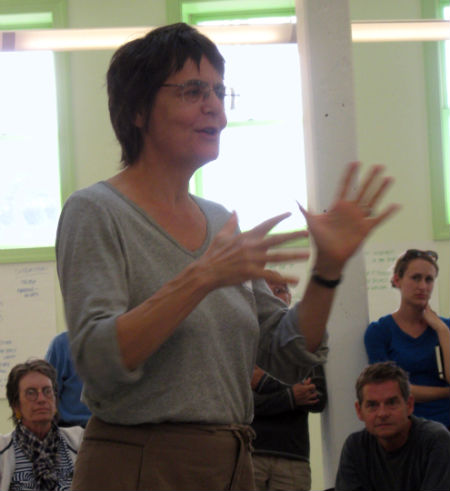Jackie Brookner, a pioneering ecological artist and educator, died of cancer on May 15, 2015. She was 69.
Born in l945 in Providence, Rhode Island she received a BA in art history from Wellesley College in l967 and completed all work for a Ph.D. in art history at Harvard except for a dissertation before shifting her focus to sculpture in l971.
Her early career as an artist working in cast bronze was informed, in part, by the welded abstract sculpture of Isaac Witkin and by the Abstract Expressionist sensibility prevalent at The New York Studio School where she studied with Nicholas Carrone. Brookner had a brief stint as a co-dean there in the l970s before beginning a long career at Parsons The New School for Design in l980 where she taught until her death. She also taught at Harvard in the Department of Visual and Environmental Studies (VES) Harvard in 2002.
Brookner was one of the few remaining artists to have originally lived in Soho when it was the international center for new art. Today the sculptures in her loft— dating from four decades —co-habit with hundreds of succulents and cacti, many of which she grew from seed or cuttings. Some plants have their roots embedded into the sculptures thus designed to encourage plant life on their surface. These are similar to her “biosculptures,” what she called living sculpture, innovative ecological projects that bridged the gap between biology, social science, art and urban architecture in major site-specific works that have been an intrinsic part of her practice for the past twenty years.
Brookner’s work was always distinguished by an engagement with natural materials. Early on she made numerous graphite drawings, small and large scale cast bronze sculpture, always informed by bodily touch and the human hand. Throughout her career there has been a metonymy between material and concept: in her later work more specifically she drew analogies between morphological patterns and systems in nature and the human body, her work crystalizing the moment when these became philosophical points about the connection between the body and the world. Local resources became the focal point for community collaboration, what Brookner called “neighborhood driven solutions” moving beyond the goal of creating permanent works of art. Likewise her writing in the l990s also anticipated by several decades recent philosophical trends in materiality and theoretical efforts to decenter and re-define the boundaries of the human in relationship to nature, ecology, and technology.
Notable among Brookner’s projects is “Of Earth and Cotton,” a series of museum installations that traveled for four years (1994-8), evolving at it crossed the southern United States. Artist Jackie Brookner followed the westward migration of the cotton belt, speaking with people who farmed and picked cotton by hand in the 1930’s and 40’s.
As people spoke about their memories, Brookner sat on the ground sculpting portraits of their feet out of soil from nearby cotton fields. The “portraits” became the focal points of the installations where they rested on 60 tons of soil or 2500 pounds of ginned cotton. Made of many different colors and textures of soil, the portraits were a metaphor for all the soils that were worked and the diversity of peoples who worked them.
The installations were accompanied by forty FSA photographs, commissioned by the US Government in the 1930’s, depicting living and working conditions of cotton farmers during the Depression
Brookner created sculptural environments throughout the United States and in Europe, at the Joan Miro Center in Barcelona, in Grossenhaim Germany, Salo Finland, and other locations. Since the late 1990s all of her work focused on plant-based water remediation. Her work Prima Lingua (First Language/First Tongue) from 2001, an iconic touchstone work for artists working with environmental issues, is a monstrously large tongue that licks the polluted water in which it stands. The mosses, liverworts and other plants that live on the surface are a fascinating microcosm that help clean air as well as filter the water. Among her recent major projects were Veden Taika (The Magic of Water), consisting of three man-made floating islands in Salo, Finland: Veden Taika was a collaboration with local volunteers, regional science experts, the students and faculty of the Salo Polytechnic Institute, the Salo Parks Department and Office of Environmental Protection. Biomatrix Water and the coordination of Finnish artist Tuula Nikulainen. Emblematic of her work, the islands provide nesting habitat for birds and plant based filtration for improving water quality in the Salo Bird Pools, lagoons that were formerly used in the sewage treatment processes of the Salo Municipal Sewage Treatment Facility. Because an abundance of migrating and nesting birds now use the lagoons, the pools have been established as a EU-directive conservation site.
At the time of her death Brookner was working on a pilot project with The City of Fargo, ND to transform a neighborhood drainage basin into a community commons that will reflect the cultural vibrancy of the Fargo community. Meanwhile, the basin will maintain its function as a storm water collection site. The “Fargo Project” was made possible thanks to a partnership with Brookner and by a $100,000 National Endowment for the Arts (NEA) Our Town Grant followed by a $450,000 grant. Brookner recently wrote to a friend, “After 5 years we are just breaking ground and there are years to go–but it is the most amazing and rewarding work I have ever done. Your wonderful questions will prod our thinking …. My own health is unfortunately quite fragile right now. I am not sure I will get to see this through, but none of us will get to do more than start the turning of the Great Wheel.”
Brookner gave a TEDx lecture on the Fargo Project in 2012.
Brookner was the recipient of numerous commissions, awards, and grants including from the Nancy Gray Foundation for Art in the Environment and the New York Foundation for the Arts. Her writings were published in The College Art Association’s Art Journal, M/E/A/N/I/N/G, WEAD Magazine, and Paper Monument’s recent book Draw it with your eyes closed: the art of the art assignment. Urban Rain: Stormwater as Resource, a book about Brookner’s water reclamation projects was published in 2009. “Art and Ecology,” her 1992 guest edited issue of Art Journal is still today considered a milestone in ecological thinking.
Brookner was an inspiring and much beloved teacher and administrator. At Parsons, she had taught in the Fine Arts MFA Program since its inception and served as the Interdepartmental Program Coordinator: Design for Social Change in 2000-2001. She was the recipient of The New School University, Pedagogical Innovation Grant in 2011.
In a statement about her practice Brookner wrote: “Hidden in the roots of our words we find what we seem to want to forget–that we are literally the same stuff as earth. My work explores this identity while undermining the assumptions and values that keep us from acknowledging it.”
She is survived by her wife Terry Iacuzzo and by her brother Philip Weinstein and nephews Noah and Benjamin. Plans for a memorial service to be held in New York in the fall will be announced at a later date.
Brookner’s last site-specific installation was her own body; wrapped in a shroud, placed on a rustic plank of wood and lowered directly into the earth that she loved so much.
by Lenore Malen and Mira Schor, May 18, 2015

